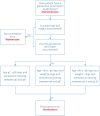Evaluation of an audit and feedback intervention to reduce gentamicin prescription errors in newborn treatment (ReGENT) in neonatal inpatient care in Kenya: a controlled interrupted time series study protocol
- PMID: 35578243
- PMCID: PMC9109356
- DOI: 10.1186/s13012-022-01203-w
Evaluation of an audit and feedback intervention to reduce gentamicin prescription errors in newborn treatment (ReGENT) in neonatal inpatient care in Kenya: a controlled interrupted time series study protocol
Abstract
Background: Medication errors are likely common in low- and middle-income countries (LMICs). In neonatal hospital care where the population with severe illness has a high mortality rate, around 14.9% of drug prescriptions have errors in LMICs settings. However, there is scant research on interventions to improve medication safety to mitigate such errors. Our objective is to improve routine neonatal care particularly focusing on effective prescribing practices with the aim of achieving reduced gentamicin medication errors.
Methods: We propose to conduct an audit and feedback (A&F) study over 12 months in 20 hospitals with 12 months of baseline data. The medical and nursing leaders on their newborn units had been organised into a network that facilitates evaluating intervention approaches for improving quality of neonatal care in these hospitals and are receiving basic feedback generated from the baseline data. In this study, the network will (1) be expanded to include all hospital pharmacists, (2) include a pharmacist-only professional WhatsApp discussion group for discussing prescription practices, and (3) support all hospitals to facilitate pharmacist-led continuous medical education seminars on prescription practices at hospital level, i.e. default intervention package. A subset of these hospitals (n = 10) will additionally (1) have an additional hospital-specific WhatsApp group for the pharmacists to discuss local performance with their local clinical team, (2) receive detailed A&F prescription error reports delivered through mobile-based dashboard, and (3) receive a PDF infographic summarising prescribing performance circulated to the clinicians through the hospital-specific WhatsApp group, i.e. an extended package. Using interrupted time series analysis modelling changes in prescribing errors over time, coupled with process fidelity evaluation, and WhatsApp sentiment analysis, we will evaluate the success with which the A&F interventions are delivered, received, and acted upon to reduce prescribing error while exploring the extended package's success/failure relative to the default intervention package.
Discussion: If effective, these theory-informed A&F strategies that carefully consider the challenges of LMICs settings will support the improvement of medication prescribing practices with the insights gained adapted for other clinical behavioural targets of a similar nature.
Trial registration: PACTR, PACTR202203869312307 . Registered 17th March 2022.
Keywords: Audit and feedback; Clinical guidelines; Inappropriate prescribing; Low- and middle-income settings; Newborns.
© 2022. The Author(s).
Conflict of interest statement
The authors declare that they have no competing interests.
Figures



References
-
- Donaldson LJ, et al. Medication without harm: who’s third global patient safety challenge. Lancet. 2017;389(10080):1680–1681. - PubMed
-
- European Medicines Agency . Medication errors. 2015.
Publication types
MeSH terms
Substances
Grants and funding
LinkOut - more resources
Full Text Sources

